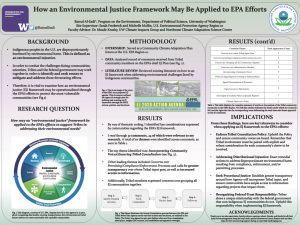How an Environmental Justice Framework May Be Applied to EPA Efforts
Indigenous communities in the United States are disproportionately burdened by environmental harm. This is defined as an environmental injustice. The United States Environmental Protection Agency (EPA) seeks to anticipate and plan for challenges faced by communities to better fulfill their stated mission of protecting human health and the environment. The aim of this study is to understand how an “environmental justice” framework may be applied to the EPA’s efforts to support Tribes in addressing their environmental needs. To address this question, I completed an internship at the EPA Region 10 as a Community Climate Adaptation Plan intern. In conjunction with this internship, I obtained a record of comments received from Tribal community members in response to the Agency’s Environmental Justice (EJ) Plan. I employed a qualitative analysis by way of thematic coding to identify the key concerns expressed by communities regarding the EPA’s EJ framework. The majority of comments fell under the theme of “Incorporating Community Voices”, and the subcategory of “Ensuring Proper Tribal Consultation”. The next leading themes under which comments fell were: “Concerns over Compliance/Enforcement Processes”; “Concern over where Tribal Input Goes”; “Concern for Grouping all EJ Communities Together”; “Concerns over Administrative Burdens”; and “Concerns over Equal Access to Information”. These findings have critical implications when understanding how to best operationalize an EJ framework through EPA’s programs, policies, and activities. It is critical to know how the Agency may establish principles for carrying out an effective application as this will, hopefully, better serve and protect communities.
